ENCORE - THE ORIGINAL PRO NITROUS: THE AHRA PRO STOCKERS
Originally published February 2003
Looking back in time to the days of nitrous doorslammers and AHRA Pro Stock
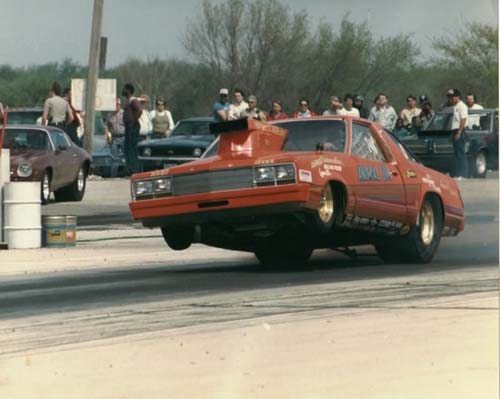
A common misconception suggests the origin of nitrous-injected doorslammer racing can be traced back to the International Hot Rod Association’s Top Sportsman division. In fact, the first organized competition for nitrous-aided door cars dates back to the American Hot Rod Association's Pro Stock class. During the last four years of the AHRA’s existence, officials bucked conventional Pro Stock regulations of the day by allowing the use of nitrous oxide.
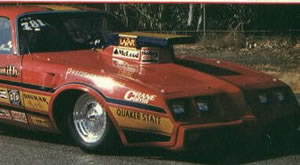 Tom Chelbana drove this neat Pontiac that actually carried horsepower from an Oldsmobile engine. The car was owned by Dave and Karen Smith and was one of two cars sponsored by NOS.
Tom Chelbana drove this neat Pontiac that actually carried horsepower from an Oldsmobile engine. The car was owned by Dave and Karen Smith and was one of two cars sponsored by NOS.
In 1980, Pro Stock was a class in transition. On the National Hot Rod Association side, Pro Stock cars were running on a pounds-per-cubic-inch basis with special weight breaks and/or handicaps based on the make of car. The IHRA took advantage of their rival’s complicated and rather unpopular structure and countered with a simplified unlimited cubic-inch format. As a result, the first Pro Stock car to break into the seven-second zone was racing under IHRA sanction
So where does AHRA Pro Stock fit into the equation? At the start of the 1980 season, the AHRA was deep in the same quagmire as the NHRA, struggling to maintain a level playing field through the use of a cumbersome rules package. To their credit, those in charge of the AHRA recognized the quandary they were in, and they reacted accordingly, making sweeping rules changes.
The 1980 AHRA Pro Stock season had gotten off to a lackluster start, but that was soon to change. The organization decided that implementing a Mountain Motor format was the best way to give the class the publicity it deserved, and inject new life into it.
There was a major problem, however.
The class was full of small block-powered cars and they had to find a way for racers to make the transition to the big-inch powerplants without making their equipment obsolete.
The solution was simple. Allowing the small block cars to run with nitrous oxide would make them competitive with the Mountain Motor-equipped machines.
A quick perusal of the rulebook revealed the following base weights: Unlimited cubic inches - 2350 lbs, and small block 2150 lbs. There were rules put in place to deduct pounds or implement penalties for using certain accessories.
For instance, if a racer ran an automatic, he or she was allowed a deduction of 100 pounds. On the other side of the coin, if a racer used a Lenco then they had to add 150 lbs. On a small block-equipped car the addition of nitrous carried a 250-pound penalty. If a racer ran a canted-valve engine such as the Ford Cleveland, they had to add another 50 pounds.
Despite the additions and subtractions and various avenues of combinations, the racers welcomed the switch, although not immediately.
One of the more famous competitors in AHRA Pro Stock was "Animal" Jim Feurer. He doesn't hold back the notion that his group put nitrous doorslammer racing on the map.
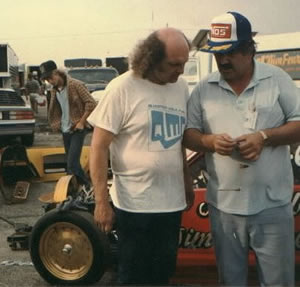 Mike Thermos (right) found his stepping-stone to fame in the nitrous ranks by working his way in AHRA Pro Stock. His NOS Nitrous Oxide Systems went on to revolutionize the industry.
Mike Thermos (right) found his stepping-stone to fame in the nitrous ranks by working his way in AHRA Pro Stock. His NOS Nitrous Oxide Systems went on to revolutionize the industry.
We were the original nitrous doorslammers, there's no doubt about that," said Feurer. "In fact, both Dave Smith and I had the first professional cars sponsored by Nitrous Oxide Systems (NOS). At the time when (NOS founder) Mike [Thermos] called me about that, in the winter of 80-81, I had already started a deal on building a big block Ford with Jack Roush. It was going to be a 600-inch mountain motor. The irony of it is that I was initially against the nitrous cars coming in the class.
"I even wrote letters to the AHRA against it and then I ended up sponsored by NOS. I didn't feel like a hypocrite. You can't feel that way when you're a racer. You do what's necessary. If you don't do it, someone else will."
Naturally, Thermos lobbied hard for the inclusion of nitrous into the class.
"We always wanted to get nitrous out there on a professional level," said Thermos. "I always felt that drag racing was where nitrous should be. We tried everywhere, and finally AHRA relented and let us put nitrous on the small motors. There was some politics that went on behind the scenes, and I'll be honest AHRA was notorious for changing the rules to fit the situation. The nitrous cars did well early.
"I don't think it was ever a class that was dying,” Thermos said. “They had a strong program. The AHRA was soft in some areas and they ran on some poor tracks. It was a great place for us because it allowed us to showcase our product."
Former champion Jerry Haas loved the AHRA format.
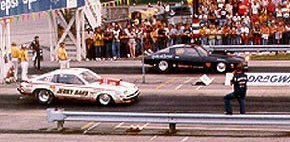 Jerry Haas (near lane) captured the 1981 Championship in his trusty Monza.
Jerry Haas (near lane) captured the 1981 Championship in his trusty Monza.
"I think it was a great place to race and I think AHRA was a great place for the racers," Haas said. "The small blocks and nitrous gave the racers a transition period. That's what I did. In 1981, I won the championship with a small motor and nitrous and that's the only way to make one competitive then. I eventually went to the big motor. The good thing about that is the guys didn't lose anything, like the truck guys did."
Former IHRA Pro Stock competitor Jerry Yeoman joined the AHRA program late in the game.
"I don't think the nitrous cars coming in was a political thing," said Yeoman. "The cars were just like the NHRA small blocks and some were still running AHRA. I really think it was a money thing more than anything. It was easier to add nitrous than to throw away everything and build a big motor. I think the small block had run its course by the time I came into the thing."
The AHRA strictly enforced rules regarding the appearance of their Pro Stock cars. They had to conform to traditional specs. Regardless of how civilized the cars looked, however, the purge of nitrous was not always eye candy to fans of the class.
According to Feurer, the nitrous racers were referred to as "bottle babies."
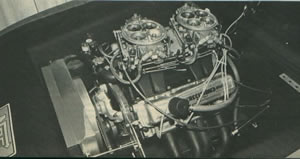 The small block Pro Stock engine with nitrous.
The small block Pro Stock engine with nitrous.
"The irony is that the majority of the group did not accept the small blocks with nitrous too well,” Feurer said. “It was nothing like it was in the early days of Pro Modified. We felt like something that the cat dragged in. A lot of people thought that we took a basic engine and bolted nitrous on it, but there was a lot more than that to it. Our motors had a lot to them."
The competition was as fierce among these guys as it was in the other sanctioning bodies. Drivers such as Lee Hunter, Shelby Jester, Jim Ehlen, Tom Chelbana, Gary Duckworth, Chuck Nyutten, and Pete Robinson provided AHRA fans with quite a show. With Feurer, Yeoman, and Haas also in the mix, AHRA Pro Stock fans had lots to cheer about. Haas said it best. "I don't one single person made the impact. We all had a part in building it."
Feurer said that Haas was probably the guy the others hated to line up beside. "He was probably the toughest. We'd get guest appearances from Don Nicholson and Lee Shepherd and Warren Johnson. When Shepherd came in, he'd go to the top. My claim to fame is that I out-qualified him once in Springfield, Missouri. I got down to the semis and he beat me.
"When these guys didn't show up, we had a chance to showcase our stuff,” Feurer said. “I can still remember the finals at Tulsa in 1982 when I met Chuck Aronson, who was in an ex-Bob Glidden car. It was the first all-Ford final. I felt like I was in drag racing paradise. There were so many people there that they broke down the fences. Also in the finals that day were Don Prudhomme and Tom Hoover, as well as Don Garlits and Jerry Ruth."
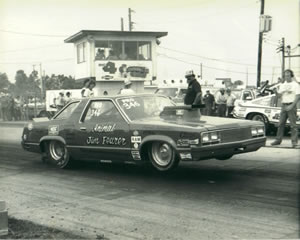 The small block Pro Stocks carried a base weight of 2150. Penalties included 250 pounds for nitrous, 150 pounds for a Lenco and an additional 50 if they ran a canted valve engine.
The small block Pro Stocks carried a base weight of 2150. Penalties included 250 pounds for nitrous, 150 pounds for a Lenco and an additional 50 if they ran a canted valve engine.
The racing in this diverse class was extremely tight, which led to more than one war. One of the biggest was not among the racers, however; it was in the media. This skirmish came from the various nitrous companies trying to grab the largest piece of the pie. Their battles were fought in the media through ads. The leading companies were NOS, Lazar, and I.C.E. (now Nitrous Works).
"The nitrous wars were serious," said Feurer. "The nitrous companies were at war. Whenever Chelbana or I did well, Thermos put us in his ads. They were full page and in color. Those are the days that built the nitrous industry. They were brutal."
Some of the ads were very brutal indeed, and some were downright comical. On one occasion an ad almost landed a racer and a nitrous company in court. When Feurer made the switch to I.C.E. from NOS and then returned to give a testimonial in an ad, some quality mudslinging took place between the parties involved.
According to Feurer, it all happened because he was disappointed with NOS, who had gotten pretty hot and heavy in the fuel ranks. Feurer felt that he was put on the backburner because of a few incidents. He felt that his interests could be better served by going with a company that had courted him for a few seasons.
"John Stewart went to Lazar and then went with I.C.E. Nitrous. He would call me all the time, just before we were about to leave and tell me all of this stuff because he wanted me to switch over. He would call me before and call me afterward. He would tell me how wonderful his stuff was and wish me luck. Afterwards, he would call me and congratulate me. No matter how well we did, even if we set track records, he would let me know that we could have done better with his stuff.
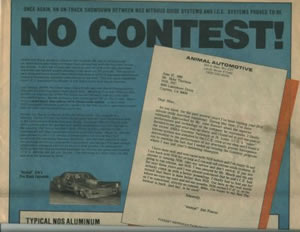 The nitrous advertising wars were brutal. This is the famous National DRAGSTER ad which almost sent Jim Feurer, NOS and I.C.E. Nitrous Systems to court.
The nitrous advertising wars were brutal. This is the famous National DRAGSTER ad which almost sent Jim Feurer, NOS and I.C.E. Nitrous Systems to court.
"If you happened to break an axle, it was because you ran NOS," Fuerer said with a laugh. "I mean, if you tripped over your trailer and fell and knocked your teeth out, it was because you were running NOS stuff. I was running out of money and my truck broke down and he caught me at a weak point and gave me a deal that I couldn't refuse. I switched for the Gateway race in St. Louis in 1983. He even brought in an engineer and he came from Arizona and they spent a week switching my car over. The engineer used to work with Roush and that solved another problem, I was short of people. He bought me a transmission for my truck and some other things and we switched over.
"On the first run at the Gateway Nationals…which I had won and shined in the previous year…I melted that motor down. When I pulled the head off you could see the crankshaft. To this day, I think it was the fastest 100 feet I ever went in my life. Apparently there was a problem with the solenoids or something like that. Before the event was over, Mike, who was at a car show in Illinois, heard about it. He showed up the next day. This happened on a Friday.
Thermos attempted to save the day for his prodigal son.
"Mike showed up and I'm of course, depressed and all…I went out Friday and got plastered cause I figured we were out of it. At this event, about 25 cars had showed up. The mountain motors were starting to fly, too. Mike came over to me and apologized and told me that if I had a spare motor that there was a spot out there for me."
Thermos pointed out, "It was just a way of doing strong business. We were competitive with our companies just like the racers were with their cars. He wounded his motor pretty bad. We did an ad that he switched and switched back, it was sort of like the cam wars."
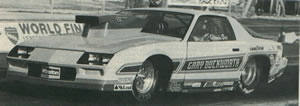 Towards the end of the AHRA era, the mountain motors began to get the best of the small motors. Gary Duckworth was one of the heavy-hitters of this combination.
Towards the end of the AHRA era, the mountain motors began to get the best of the small motors. Gary Duckworth was one of the heavy-hitters of this combination.
Here’s that infamous National DRAGSTER ad and the testimonial letter that caused the ruckus.
It read,
Dear Mike,
As you know for the last several years I have been running your NOS nitrous oxide injection equipment. During this time, Mr. John Stewart has constantly approached me about the superior performance and technology of the company he represents. I finally decided to see just what was out there, and I found out in just one pass at the recent AHRA Gateway Nationals in
I.C.E.'s "super" nitrous system was installed by the I.C.E. crew at my shop and I found it detrimental to the performance of my previously proven horsepower, not to mention the fact that I ended up missing the Gateway program where I was last year's defending champion.
I have done well and won races with NOS before and I'm happy to say I am back with NOS for as long as I run and sell nitrous oxide systems. If anyone is running NOS, take my advice and don't switch. If you are going to run nitrous, use NOS. I was swayed by Mr. Mouth and his ads for over three years and I was almost convinced that he and I.C.E. had come up with a better mousetrap. I finally had to find out for myself that there is none better than NOS.
Out here in the real world where we race our cars and not our mouths, NOS versus I.C.E. is, as far as I'm concerned, strictly no contest. Mike I'm happy to say that "The Animal" is back. And, boy is he mad!
Sincerely,
"Animal" Jim Feurer
Yesterday, in our visit back to the archives, we told the story of the pounds-per-cubic inch era for NHRA Pro Stock. Today, we delve a bit deeper with a look back at the early days of 500-inch Pro Stock. #ClassicDragRacing #dragracingnews - https://t.co/Y4rOIvObgk pic.twitter.com/Sr4NomfzVe
— Competition Plus (@competitionplus) December 19, 2019
Needless to say, the ad stirred an already infuriated hornet's nest. The already competitive market led to Feurer's phone ringing off of the hook. According to him, he received calls from the owner of I.C.E., the crew guy and even I.C.E.'s advertising agency. Cooler heads prevailed and while it never went to court, it came close.
Thermos added one more detail that may fall in the category of "too much information."
"The funny thing about the whole deal is that we had neglected to get a room for the night and at the last minute, about 2 am, one came open. There were 5 of us. We had one bed and I slept on one corner and Jim got on the other. We were so tired that we didn't even shower that night. We woke up greasy and I looked over at Jim and he was in a state of disarray in appearance. I looked at him and told him that I had to sleep with him to get him back."
 Even Haas remembered those days of the nitrous wars.
Even Haas remembered those days of the nitrous wars.
"It was serious business. I started off with Lazar. There was NOS, and Lazar and I.C.E. merged. I.C.E. and NOS had the most colorful feuds. It was funny to watch at the time. We were all learning and the nitrous companies were too. Some said throw a lot of nitrous at it. We realized that we had to get the motor set up first."
That was the key to making it work, knowing how to factor in the nitrous. It was no easy task according to the parties involved.
Thermos pointed out, "That was at a time when everyone was just trying to get his or her feet on the ground, and naturally it was very competitive. Everyone was learning about nitrous and it's potential.
This deal really caused a lot of controversy. The motto was who could make the most horsepower. That was a negative in a few instances because the rods got thrown out. I think we chose to lean on the conservative side and work with the racers a little stronger. In the long run, our theory prevailed."
Feurer had the Ford perspective. "That Cleveland really liked nitrous, but it didn't hold up all that well," he said. "We were still using original parts, highly modified and massaged, and aftermarket stuff was basically non-existent. We had the mountain motors corralled until about 1983 and that's when the aftermarket stuff came around and so did the mountain motors. It got harder and harder to keep head gaskets in there and we didn't have the luxury of up-to-date electronics.
"If we had the MSD and the stuff like we have now, we would have known exactly how much to retard and the tune-ups and the foggers…holy crap…it would have really been unbelievable. We ran in the sevens back in those days. I ran as quick as a 7.78 in 1982."
The most oddball of combinations belonged to the Oldsmobile-powered, Pontiac of Dave and Karen Smith that carried a diesel block.
"The first year we did it, we went to Tucson, and Dave Smith and his driver Tom Chelbana just went back and forth setting the record," recalled Feurer. "You could take that Olds of his and almost make it 500-inches, but you couldn't do that with the Cleveland. I was up to 430."
According to former Drag Racing Magazine editor Dave Wallace, AHRA allowed the Olds-powered Pontiac Trans Am of Dave Smith because Pontiac had begun installing the 403 Olds (gasoline) engine in Trans-Ams after exhausting the supply of 400-inch Pontiacs.
As time progressed, the small blocks eventually fell behind the mountain motor entries such as the one that Yeoman ran.
"Well, the cubic inch size, was going to naturally wear the small motors down forcing them to keep up," explained Yeoman. "As technology improved so did this combination. Torque led to more horsepower and the big motors eventually took over."
"I think the nitrous added flavor to the class, but it didn't take long for the big motors to build a gap between the two," recalled Yeoman. "The small block died after a while. It made things great for the announcers and it helped to hype the class. The small blocks helped to develop an underdog scenario."
As all good things must come to an end, so did the AHRA, and it brought the class down with it.
Haas said, "It's really sad that it all went away. AHRA was one of three sanctioning bodies. They had something for everyone. It's sad and a shame it couldn't come back."
When one door closes, another usually opens.
"Those guys laid the groundwork for what is Pro Modified today," explained Thermos. It worked out well; it was hard to keep the parity. That's why after the AHRA dissolved; we went to the IHRA looking for a place to showcase our product. I approached Ted Jones and then it eventually led to Pro Modified."
Long before the 500-inch Pro Stock became the norm, the NHRA factored the factory hot rods on a pounds per cubic inch basis. We've gone back into our archives for a 2003 article which tells of those days. #DragRacingNews #ClassicDragRacing - https://t.co/iAde8aNRRs pic.twitter.com/DIjzma0v4Y
— Competition Plus (@competitionplus) December 18, 2019
Could this format work in today's technology and racing world?
"I don't know it would work," said Feurer. "But, you never know, we have those 5.0 Mustangs running in the 6s now. They can really do some things with those small blocks. It would be interesting thing. I supposed if it had evolved over the years, it would still work. But, the AHRA went under and that killed it all."
Yeoman probably summed it up the best by offering his assessment. "I don't think it would work today. It was good while it lasted and it left some last memories. But, that's all they will be is memories. The class had a lot of camaraderie like over in the IHRA. It was a fun time for all of those that participated. This was a working man's class."









































